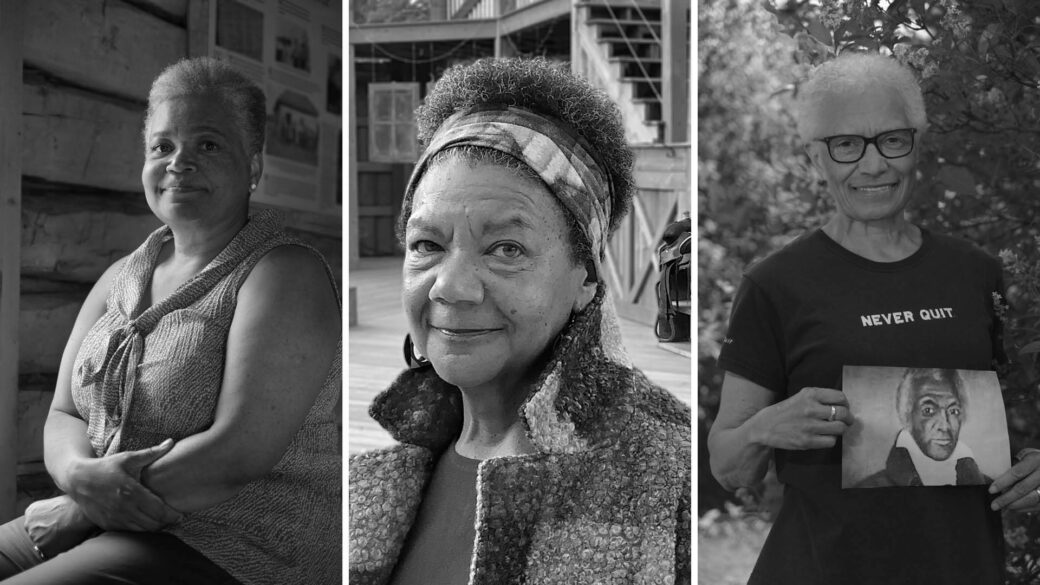
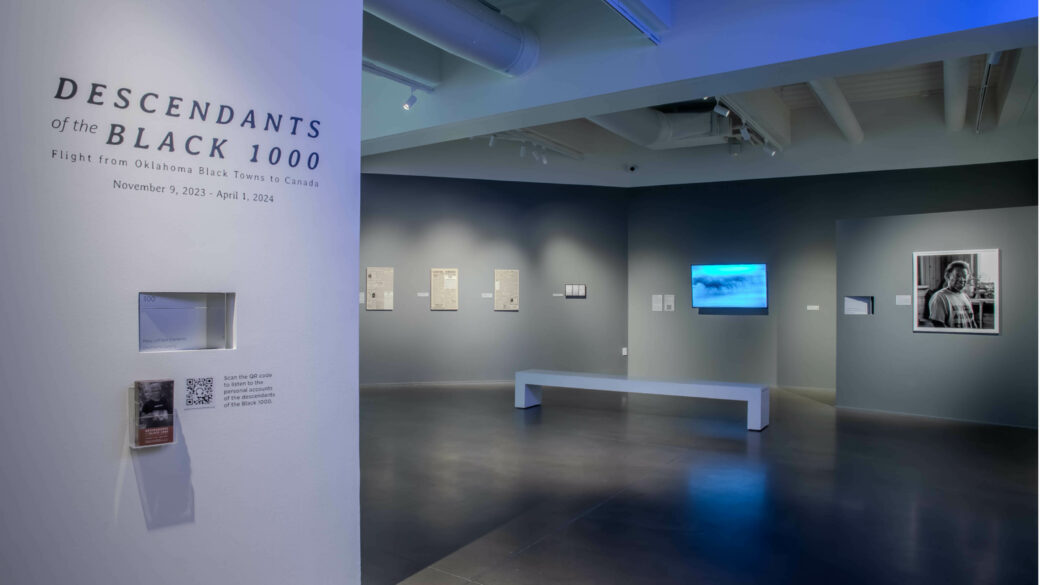
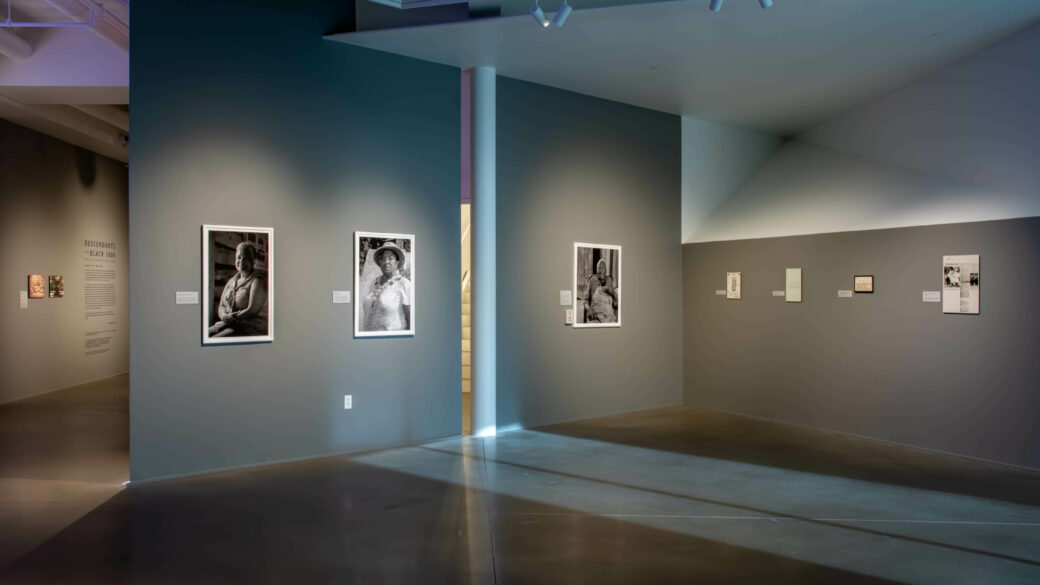








Nov. 9, 2023-April 1, 2024
Mary LeFlore Clements Oklahoma Gallery
View the Artist Talk here
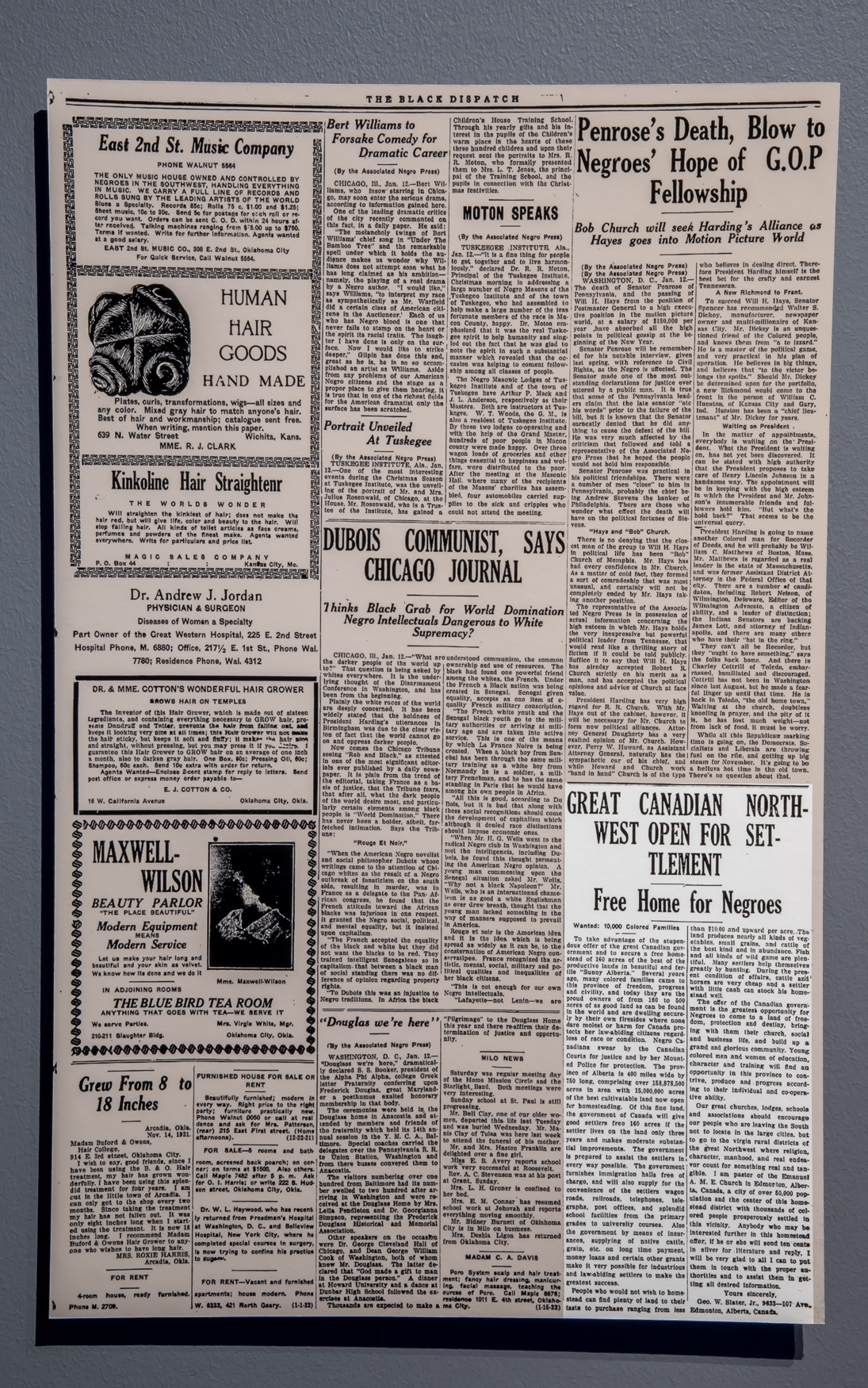
Descendants of the Black 1000: Flight from Oklahoma Black Towns to Canada featured the work of Canadian artists Donna Paris and David Ofori Zapparoli, whose collaborative project foregrounded untold stories that traced the historical movement of Black communities over time. A selection of 12 photographs with corresponding oral history audio recordings from their project Black Threads of the Canadian Tapestry revealed the deep connections between Black Canadians and Oklahoma, from where many of the portrait sitters’ forebears hailed. Through photographs, interviews, and archival materials, Descendants of the Black 1000 created a fuller picture of how Black history in Oklahoma had an international reach, going beyond the state and connecting communities across the continent.
Through the black-and-white portraits and the poignant voices of the descendants of the Black 1000, we learned of the events that led those seeking freedom to leave Oklahoma and find refuge in Canada. Black presence and movement within Oklahoma is longstanding. The emergence of Black Towns during and after slavery, along with the land runs in the early 1900s, brought Freedmen and other formerly enslaved settlers to the region seeking safe haven in our state.
Prior to statehood in 1907, what was previously known as Indian Territory was in the process of evolving into an egalitarian place, unusually progressive at the time. With the Five Nations having abolished slavery at the end of the Civil War, citizenship and land rights offered in the area made it attractive to Black settlers.

However, upon statehood, the first legislation written into state law was segregation that enforced disenfranchisement, enacted Jim Crow laws, and systemically stoked racial animosity toward Black Oklahomans, leading to flight further west, to Mexico, and to Canada. Between 1908 and 1911, more than 1,000 Black Oklahomans migrated to the Canadian prairies in Alberta and Saskatchewan.
Descendants of the Black 1000: Flight from Oklahoma Black Towns to Canada revealed an important story that not only charted the migration but also captured the human spirit that stirred people into movement away from persecution, speaking to how the promise of land can be blighted. The sheer will to traverse expanses to unknown areas within the continent toward safety and freedom–what it takes to clear and cultivate land in a new place with harsh winters and to build homes and forge community from the ground up–was drawn from a wellspring of fortitude and hope passed down to descendants. The story continues.

Descendants of the Black 1000: Flight from Oklahoma Black Towns to Canada was organized by Gay Pasley, guest curator, with the support of Joy D’Ann Tucker, guest curatorial research associate, in collaboration with Oklahoma Contemporary.
Descendants of the Black 1000 Programs
Feb. 10 | We Are the Roots: Film Screening & Discussion

Artist
Donna Paris (b. 1955, Nova Scotia, Canada) is a multi-generational African Canadian based in Toronto. She has produced a series of interviews chronicling the various journeys taken by African Canadians and their ancestors to arrive north. Paris’s work centers the importance of collective history—who came before and at what cost—toward enabling us to fully access our present selves and move forward together.
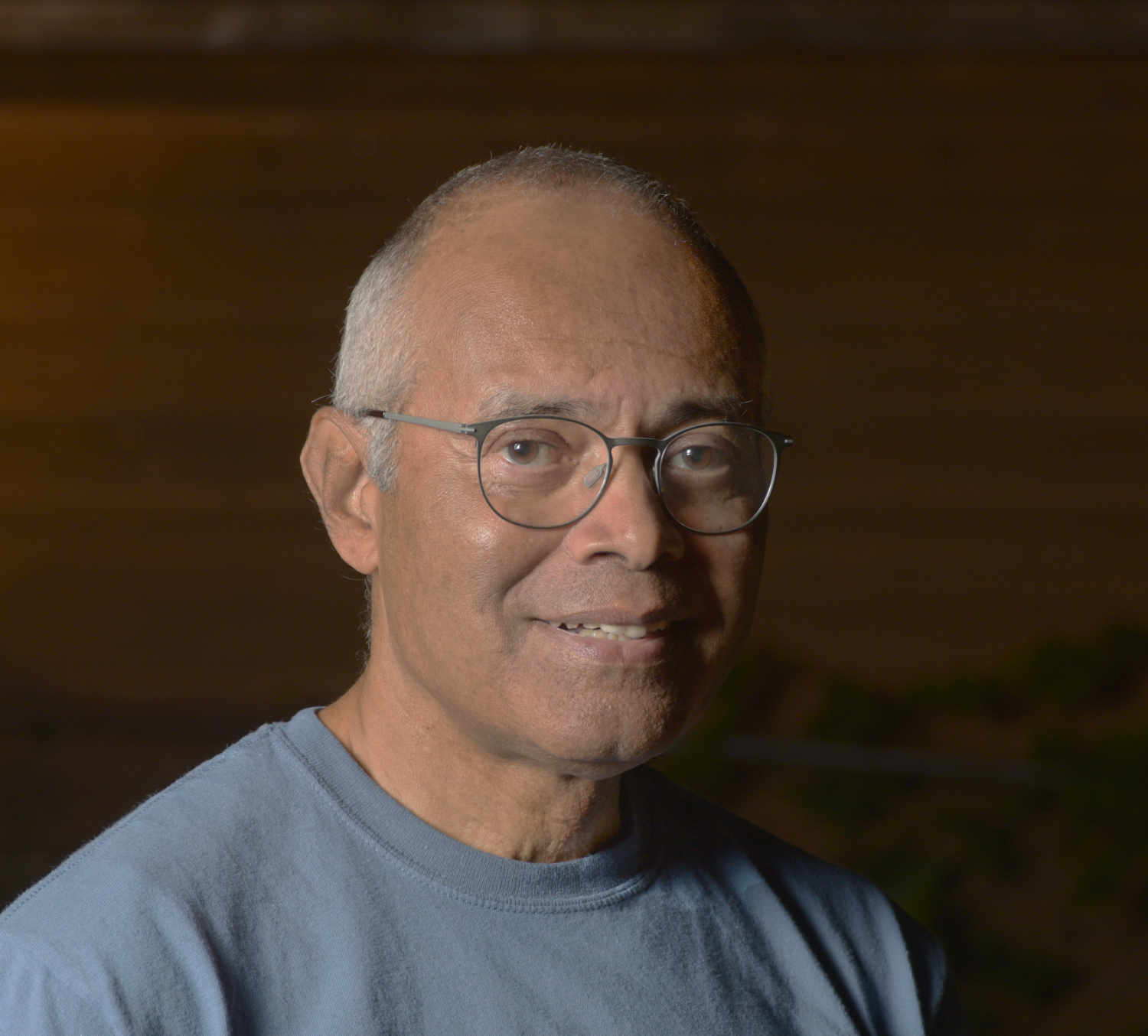
Artist
Based in Toronto, David Ofori Zapparoli (b. 1957, Toronto, Canada) is the son of a German mother, a Ghanaian father, and an Italian stepfather. His lens-based art documents and reveals the lives of the marginalized within society, telling the story particularly of the Black experience in the North American milieu. Zapparoli collaborates with artist Donna Paris by producing the photographic portraits of all the interviewees. His black-and-white photographs tend to resist the viewer’s ability to pinpoint the place and time of each subject, opening the possibility of connecting to other locales and histories.

Guest Curator
Gay Pasley is a social justice nurse, community leader, writer, and photographer, whose work has been featured in Abstract, Loud Zoo, and Maintenant: A Journal of Dada Writing and Art. She is also a regular contributor to Art Mama Moves. A graduate of the Oklahoma City Red Earth MFA Program, she has given lectures at organizations such as the International Association of Forensic Nurses, John Hope Franklin Center for Reconciliation, Ralph Ellison Foundation, Scissortail Writing Festival, and Society for Photographic Education. Pasley is the 2023 winner of the Everett Southwest Literary Award and has been published in Amistad, elsewhere, Flatbush Review, Hard Crackers Press, Morkan’s Horse, Minola Review, Obsidian Literature & Arts in the African Diaspora, Snapdragon: A Journal of Art & Healing, Thread, and Transition, among others. As a Black female immigrant, Pasley speaks to her sense of displacement and desire to magnify her witness in her artistic practice.

Guest Curatorial Research Associate
Joy D’Ann Tucker grew up in Clovis, New Mexico, where her multicultural and art-infused upbringing influenced her love for the arts. A graduate of the University of Central Oklahoma, she majored in history and museum studies and served two internships at the Smithsonian's National Museum of American History as a junior curator in Culture and Community Life and in Museum Management and Installation. At Oklahoma City Museum of Art, Tucker was an intern in Communications and Marketing. She served as the 2021 ArtTable Fellow at Oklahoma Contemporary, contributing an essay to the exhibition brochure for Rope/Fire/Water. She subsequently received a one-year grant at the Oklahoma History Center, where she digitized the African American collection archives from 1910 to 1980 as project coordinator. She aspires to contribute to the incorporation of West African and Afro-diasporic arts and culture in local and national museum institutions.
Images:
David Ofori Zapparoli. Details, Charlotte Williams (née Mayes), Cheryl Foggo, and Carol LaFayette-Boyd, 2022. From the series Black Threads of the Canadian Tapestry. Inkjet print on velvet rag paper. © David Ofori Zapparoli. Image courtesy of the artist.
Installation view of Descendants of the Black 1000: Flight from Oklahoma Black Towns to Canada, including Solomon Sir Jones Films (1924-1928), David Ofori Zapparoli's LeRoy Williams (2023), a mule shoe ca. 1914 and David Ofori Zapparoli's Vant Hayes (2022). © David Ofori Zapparoli. Photo by Ann Sherman.
Installation view of Descendants of the Black 1000: Flight from Oklahoma Black Towns to Canada, including facsimiles of historical photographs, David Ofori Zapparoli's Charlotte Lynn Williams (née Mayes) (2022), Debbie Beaver (2023), Milton Budd Phipps (2023) and facsimiles of archival materials. © David Ofori Zapparoli. Photo by Ann Sherman.
Installation view of Descendants of the Black 1000: Flight from Oklahoma Black Towns to Canada, including David Ofori Zapparoli's Judy Williams Graham (2023), Leander Lane (2023), and Cheryl (née Melton) (2023). © David Ofori Zapparoli. Photo by Ann Sherman.
Installation view of Descendants of the Black 1000: Flight from Oklahoma Black Towns to Canada, including Solomon Sir Jones Films and David Ofori Zapparoli's LeRoy Williams (2023). © David Ofori Zapparoli. Photo by Ann Sherman.
Facsimile of a newspaper page featuring “Great Canadian Northwest Open for Settlement” by Geo. W. Slater Jr., in The Black Dispatch, Thursday, January 12, 1922. Courtesy of the Oklahoma Digital Newspaper Program, Oklahoma Historical Society. Photo by Ann Sherman.
David Ofori Zapparoli, Vant Hayes, 2022. From the series The Black Threads of the Canadian Tapestry, 2019-present. Inkjet print on velvet rag paper, 34 x 22 in. © David Ofori Zapparoli. Image courtesy of the artist.
Facsimile of a letter written by Reverend William H. Hurt in “Subject, policy and case files in the First Central Registry series of the Immigration Program, 1892-1950.” © Government of Canada. Image courtesy of Library and Archives Canada.
Donna Paris. Photo by David Ofori Zapparoli.
David Ofori Zapparoli. Photo by the artist.
Gay Pasley. Photo by Jeffrey Nicholson.
Joy D'Ann Tucker. Photo courtesy of University of Central Oklahoma.
Monday 11 a.m. - 6 p.m.
Closed Tuesday
Wednesday 11 a.m. - 6 p.m.
Thursday 11 a.m. - 9 p.m.
Friday - Sunday
11 a.m. - 6 p.m.
see additional holidays
Visit us at
11 NW 11th St.
Oklahoma City, OK 73103
Phone: 405 951 0000
Fax: 405 951 0003
info@okcontemp.org
SEND MAIL TO
Oklahoma Contemporary
P.O. Box 3062
Oklahoma City, OK 73101
STAY UP TO DATE
Join our mailing list to learn about our events, exhibitions, education and more.
©2024 Oklahoma Contemporary All Rights Reserved.